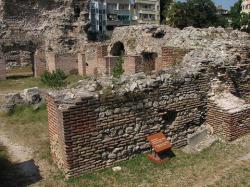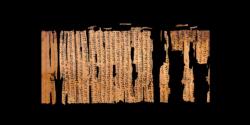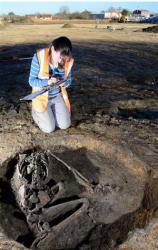INSTITUT SUPERIEUR D'ANTHROPOLOGIE
INSTITUTE OF ANTHROPOLOGY
ONLINE COURSES / COURS A DISTANCE
OPEN COURSE : FEBRUARY 2013
HRM 104 : INTRODUCTION TO INTANGIBLE CULTURAL HERITAGE
REGISTER NOW
BULGARIE -  Varna - Bulgarian Deputy Prime Minister and Finance Minister, Simeon Djankov, has pledged the significant amount of BGN 3 M for restoration and conservation of the historical Roman Baths in the Black Sea city of Varna. The Public Baths of Odessos are one of the most preserved architectural monuments of the Roman Age in Bulgaria (1st – 4th century AD). They are of the so called "small imperial style" and their construction refers to the end of the 2nd century AD. This is the largest roman bath on the Balkan Peninsula – with an area of 7000 square meters. It is the forth in size in Europe – among the baths of Karakala and Diocletian in Rome and Trevira (Trier, Germany). It was used by the end of 3rd century.
Varna - Bulgarian Deputy Prime Minister and Finance Minister, Simeon Djankov, has pledged the significant amount of BGN 3 M for restoration and conservation of the historical Roman Baths in the Black Sea city of Varna. The Public Baths of Odessos are one of the most preserved architectural monuments of the Roman Age in Bulgaria (1st – 4th century AD). They are of the so called "small imperial style" and their construction refers to the end of the 2nd century AD. This is the largest roman bath on the Balkan Peninsula – with an area of 7000 square meters. It is the forth in size in Europe – among the baths of Karakala and Diocletian in Rome and Trevira (Trier, Germany). It was used by the end of 3rd century.
http://www.novinite.com/view_news.php?id=147232
BELIZE –  Ka’Kabish - Archaeologists from Trent University have discovered a rare jade artefact, one of the first of its kind to be found in an archaeological dig, while excavating the ancient Maya city of Ka’Kabish in Belize. The six centimetre jade object, known as an Olmec spoon, was unearthed in June 2012 from a 2,700 year old grave beneath the Ka’Kabish plaza along with 16 other jade artefacts. Similar objects have been recovered in Mesoamerica, but this is one of the first times an Olmec spoon has been found in a secure archaeological site. “Examples of these objects exist in museums, but they are largely from private collections, meaning they lack the archaeological details necessary for us to understand how and when these pieces were used,” said Dr. Haines, assistant professor of Anthropology at Trent University and Ka’Kabish research project director. “These objects are rare to begin with and this is one of only two of this type that have been found undisturbed.” Professor Haines said her team’s discovery will help answer questions about how Olmec spoons were used. “We found the object buried with dozens of marine shell beads so, in this case, we know it was worn on a necklace,” she said. The purpose of Olmec spoons is still unknown. Other researchers have speculated that they were used for snuffing hallucinogens or bloodletting or even weaving. Based on the location of the grave and the number of jade artefacts recovered, Prof. Haines believes the person buried there could be one of the city’s founders. Prof. Haines is writing an article about her team’s findings that she hopes to have published in an academic journal this year.
Ka’Kabish - Archaeologists from Trent University have discovered a rare jade artefact, one of the first of its kind to be found in an archaeological dig, while excavating the ancient Maya city of Ka’Kabish in Belize. The six centimetre jade object, known as an Olmec spoon, was unearthed in June 2012 from a 2,700 year old grave beneath the Ka’Kabish plaza along with 16 other jade artefacts. Similar objects have been recovered in Mesoamerica, but this is one of the first times an Olmec spoon has been found in a secure archaeological site. “Examples of these objects exist in museums, but they are largely from private collections, meaning they lack the archaeological details necessary for us to understand how and when these pieces were used,” said Dr. Haines, assistant professor of Anthropology at Trent University and Ka’Kabish research project director. “These objects are rare to begin with and this is one of only two of this type that have been found undisturbed.” Professor Haines said her team’s discovery will help answer questions about how Olmec spoons were used. “We found the object buried with dozens of marine shell beads so, in this case, we know it was worn on a necklace,” she said. The purpose of Olmec spoons is still unknown. Other researchers have speculated that they were used for snuffing hallucinogens or bloodletting or even weaving. Based on the location of the grave and the number of jade artefacts recovered, Prof. Haines believes the person buried there could be one of the city’s founders. Prof. Haines is writing an article about her team’s findings that she hopes to have published in an academic journal this year.
http://www.trentu.ca/newsevents/newsreleases_130124belize.php
JAPON – Tottori - A team of Japanese archaeologists has found a bronze comma-shaped bead, which is believed to be the oldest of its kind in the country's history, in the western Japanese city of Tottori, local press reported on Thursday. The metal curved bead, dating back to the early sixth century, was excavated from one of the tombs built in the early sixth 6 century at the Matsubara No. 10 Mound in the city according to the daily Mainichi Shimbun. The city said the team has uncovered an area of about 1,100 square meters in the site since May 2012, adding that its members discovered the greenish colored artifact, which weighs 1.6 grams and is 1.71 centimeters long and 0.6 centimeters wide, together with about 20 glass beads during the excavation work for the tomb. After the discovery, the research institute for cultural properties in Nara Prefecture confirmed that the bronze comma- shaped bead at the tomb was made decades earlier than the one hitherto had found in western Japan. Kunihiko Sakata, a spokesperson for the city's cultural assets division said to Xinhua that since we can estimate the metal artifact found from one of the remains in Tottori is the oldest in Japan, we think there must be influential groups or peoples around the region in ancient times. "We need more continue field investigations to reveal the whole history," Sakata added. The bead will be displayed in the city museum next month.
http://english.cntv.cn/20130124/104870.shtml
PAKISTAN –  Gandhara - The oldest surviving Buddhist texts, preserved on long rolls of birch-tree bark, are written in Gandhari, an early regional Indic language that is long extinct. The scrolls originate from the region known in ancient times as Gandhara, which lies in what is now Northwestern Pakistan. For researchers interested in the early history of Buddhism, these manuscripts represent a sensational find, for a number of reasons. The first is their age. Some of the documents date from the first century BC, making them by far the oldest examples of Indian Buddhist literature. But for the experts, their contents are equally fascinating. The texts provide insights into a literary tradition which was thought to have been irretrievably lost, and they help researchers to reconstruct crucial phases in the development of Buddhism in India. Furthermore, the scrolls confirm the vital role played by the Gandhara region in the spread of Buddhism into Central Asia and China. At LMU Munich a team of researchers led by LMU Indological scholar Professor Jens-Uwe Hartmann and Professor Harry Falk of the Free University of Berlin has just begun the arduous job of editing the manuscripts. Most of the texts survive only as fragments, which must first be collated and reassembled. The researchers work not with the manuscripts themselves, but with digital scans. The originals are not only extremely fragile, but are held in various collections scattered around the world. A large fraction of the surviving material is stored in the British Library in London.
Gandhara - The oldest surviving Buddhist texts, preserved on long rolls of birch-tree bark, are written in Gandhari, an early regional Indic language that is long extinct. The scrolls originate from the region known in ancient times as Gandhara, which lies in what is now Northwestern Pakistan. For researchers interested in the early history of Buddhism, these manuscripts represent a sensational find, for a number of reasons. The first is their age. Some of the documents date from the first century BC, making them by far the oldest examples of Indian Buddhist literature. But for the experts, their contents are equally fascinating. The texts provide insights into a literary tradition which was thought to have been irretrievably lost, and they help researchers to reconstruct crucial phases in the development of Buddhism in India. Furthermore, the scrolls confirm the vital role played by the Gandhara region in the spread of Buddhism into Central Asia and China. At LMU Munich a team of researchers led by LMU Indological scholar Professor Jens-Uwe Hartmann and Professor Harry Falk of the Free University of Berlin has just begun the arduous job of editing the manuscripts. Most of the texts survive only as fragments, which must first be collated and reassembled. The researchers work not with the manuscripts themselves, but with digital scans. The originals are not only extremely fragile, but are held in various collections scattered around the world. A large fraction of the surviving material is stored in the British Library in London.
http://www.heritagedaily.com/2013/01/indian-buddhism-birch-bark-treasures/
GRECE – Thessalonique - Excavation work during construction of a new subway network in Greece's second largest city has discovered an ancient wreath made of gold that was buried with a woman some 2,300 years ago. Archaeologists say Friday's find in Thessaloniki occurred on the site of an ancient cemetery in the west of the northern port city. A total 23,000 ancient and medieval artifacts have been found during archaeological excavations connected with the construction since 2006. Archaeologist Vassiliki Misailidou said the olive branch wreath made of gold was buried in a simple, box-shaped woman's grave. It dates to the late 4th or early 3rd century B.C. Another eight golden wreaths were discovered in a single grave four years ago during subway work. The much-delayed construction project is expected to be finished in 2017.
http://phys.org/news/2013-01-subway-greece-unearths-ancient-gold.html
ROYAUME UNI –  Soham - Archaeologists have unearthed decapitated human remains beneath former allotment land in Soham. Experts from the Hertford-based firm Archaeological Solutions are currently excavating a Roman settlement on land off Fordham Road, before 96 homes are built on the site. Among the wealth of artefacts found are a number of human burials thought to predate the Roman settlement, including one where the person was decapitated before being put in the ground. Andrew Peachey, a specialist in prehistoric and Roman pottery at the company, said: “Prior to the Roman settlement, the margins of the Fen and island [of Ely] were heavily exploited by prehistoric settlers, including one who appears to have been decapitated before being placed in a crouched burial in a circular pit. “The reasons for decapitation are purely theoretical at this stage. One is obviously execution and another is to prevent ghosts. “Quite often the head is found somewhere on the site, but it’s rare for it to be completely missing. This then throws up the question of where the head was taken.” The dig is expected to continue until the end of this month.
Soham - Archaeologists have unearthed decapitated human remains beneath former allotment land in Soham. Experts from the Hertford-based firm Archaeological Solutions are currently excavating a Roman settlement on land off Fordham Road, before 96 homes are built on the site. Among the wealth of artefacts found are a number of human burials thought to predate the Roman settlement, including one where the person was decapitated before being put in the ground. Andrew Peachey, a specialist in prehistoric and Roman pottery at the company, said: “Prior to the Roman settlement, the margins of the Fen and island [of Ely] were heavily exploited by prehistoric settlers, including one who appears to have been decapitated before being placed in a crouched burial in a circular pit. “The reasons for decapitation are purely theoretical at this stage. One is obviously execution and another is to prevent ghosts. “Quite often the head is found somewhere on the site, but it’s rare for it to be completely missing. This then throws up the question of where the head was taken.” The dig is expected to continue until the end of this month.
http://www.cambridge-news.co.uk/Ely/Headless-skeleton-unearthed-from-era-before-the-Romans-23012013.htm